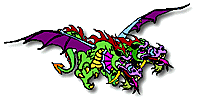
Illustrated by: Dr. Biology
![]() It was Sunday night, 1993. This may have been a usual night except this Sunday was Halloween and what happened was ASU's most famous reptile died. A Common Kingsnake, Lampropeltis getula californiae, but this snake was anything but common. From the title of our story, you may have guessed that our snake, or maybe we should call it snakes, had two heads.
It was Sunday night, 1993. This may have been a usual night except this Sunday was Halloween and what happened was ASU's most famous reptile died. A Common Kingsnake, Lampropeltis getula californiae, but this snake was anything but common. From the title of our story, you may have guessed that our snake, or maybe we should call it snakes, had two heads.
Spooky, you say? Our two headed friend had already lived 17 slinky and to some creepy years before that Halloween night. But to give up the ghost when demons and dragons are running about, even if the demons and dragons are costumes filled with children, it was just weird!
Such a serpent also makes you think of myths. Is it possible that the legends of dragons especially the two headed kind came from previous two headed snakes? Maybe the accidental finding of a  skeleton of another two headed snake lead people to make up stories of mythical flying dragons. What do you think?
skeleton of another two headed snake lead people to make up stories of mythical flying dragons. What do you think?
If you visit ASU you may want to stop by the snake collection, which includes a fair-skinned, pink-eyed albino rattlesnake, an albino gopher snake and maybe the ghost of our long time friend, the two headed snake. The reptile collection is located on the first floor of the Life Sciences Building (A Wing). The exhibit can be viewed by the public Monday through Friday, 8 a.m. to 5 p.m.
Read more about: The Tale of the Two-Headed Lampropeltis getula californiae
Bibliographic details:
- Article: The Tale of the Two-Headed Lampropeltis getula californiae
- Author(s): CJ Kazilek
- Publisher: Arizona State University School of Life Sciences Ask A Biologist
- Site name: ASU - Ask A Biologist
- Date published: 28 Sep, 2009
- Date accessed:
- Link: https://askabiologist.asu.edu/explore/two-headed
APA Style
CJ Kazilek. (Mon, 09/28/2009 - 10:10). The Tale of the Two-Headed Lampropeltis getula californiae. ASU - Ask A Biologist. Retrieved from https://askabiologist.asu.edu/explore/two-headed
Chicago Manual of Style
CJ Kazilek. "The Tale of the Two-Headed Lampropeltis getula californiae". ASU - Ask A Biologist. 28 Sep 2009. https://askabiologist.asu.edu/explore/two-headed
CJ Kazilek. "The Tale of the Two-Headed Lampropeltis getula californiae". ASU - Ask A Biologist. 28 Sep 2009. ASU - Ask A Biologist, Web. https://askabiologist.asu.edu/explore/two-headed
MLA 2017 Style
Be Part of
Ask A Biologist
By volunteering, or simply sending us feedback on the site. Scientists, teachers, writers, illustrators, and translators are all important to the program. If you are interested in helping with the website we have a Volunteers page to get the process started.


